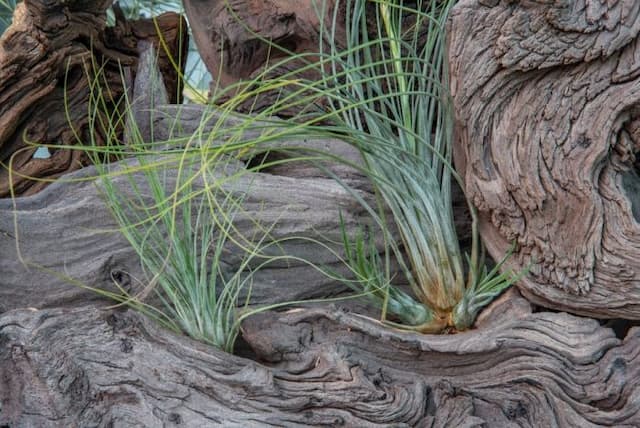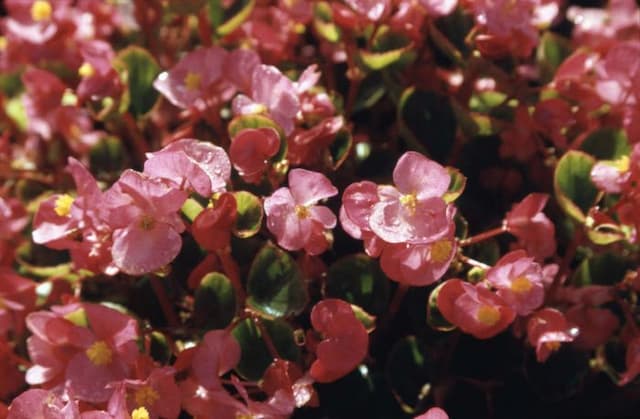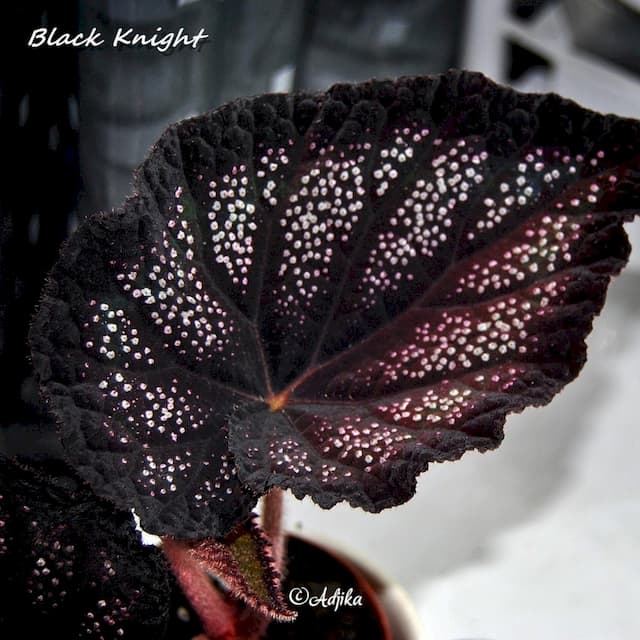King begonia Begonia rex (R)

ABOUT
Begonia rex, commonly known as King Begonia, showcases a spectacular display of richly colored leaves that are the focal point of its appearance. The striking foliage boasts a variety of patterns including swirls, spots, and stripes, which often shimmer with a metallic sheen. The leaf colors are a dramatic blend, ranging from deep greens to silvers, reds, pinks, and purples, with each leaf outlined by a contrasting, often reddish margin. The leaves themselves are broad with a somewhat fleshy texture, displaying a heart or star-like shape that contributes to the plant's ornamental charm. Despite this plush appearance, the leaves have a delicate nature, which adds to the King Begonia's appeal. Its growth is generally compact, forming a dense cluster of these opulent leaves. The plant occasionally produces small flowers, but they are typically overshadowed by the magnificent foliage. Overall, the King Begonia is prized for its stunning leaf coloration and intricate patterns, which make it a popular choice for indoor plant enthusiasts seeking a visually captivating specimen.
About this plant
 Names
NamesFamily
Begoniaceae.
Synonyms
King Begonia, Painted Leaf Begonia, Fancy-Leaf Begonia, Rex Begonia.
Common names
Begonia rex
 Toxicity
ToxicityTo humans
The Begonia rex, commonly referred to as the Rex Begonia, is generally considered non-toxic to humans. However, ingesting any part of the plant can potentially cause mild irritation in the mouth or throat due to the presence of calcium oxalate crystals. If ingested, the most common symptoms might include a burning sensation in the lips, tongue, and throat, and possibly nausea or vomiting.
To pets
The Rex Begonia is toxic to pets, particularly cats and dogs. If ingested, it can cause irritation in the mouth, tongue, and lips due to the calcium oxalate crystals present in the plant. Symptoms of poisoning in pets can include drooling, pawing at the mouth, vomiting, and difficulty swallowing. It is advisable to keep this plant out of reach of pets and to seek veterinary attention if any part of the plant is ingested.
 Characteristics
CharacteristicsLife cycle
Perennials
Foliage type
Evergreen
Color of leaves
Mixed
Flower color
Pink
Height
1-1.5 feet (30-45 cm)
Spread
1-1.5 feet (30-45 cm)
Plant type
Herb
Hardiness zones
10
Native area
India
Benefits
 General Benefits
General Benefits- Aesthetic Appeal: The Begonia rex, or King Begonia, adds visual interest to any indoor space with its vibrant foliage that comes in a variety of colors and patterns.
- Low Maintenance: It requires minimal care, making it suitable for busy individuals or those new to keeping plants.
- Humidity Loving: Thrives in high humidity environments, which can be beneficial for keeping indoor humidity levels comfortable.
- Improves Wellbeing: Caring for plants like the King Begonia can reduce stress and improve overall wellbeing through the act of nurturing.
- Versatility in Design: Its unique appearance allows it to fit into a variety of decor styles, from modern to tropical.
- Pet Friendly: The King Begonia is non-toxic to pets, making it a safe choice for households with animals.
 Medical Properties
Medical PropertiesThis plant is not used for medical purposes.
 Air-purifying Qualities
Air-purifying QualitiesThis plant is not specifically known for air purifying qualities.
 Other Uses
Other Uses- Begonia rex can be used as a natural humidity indicator; when the humidity is low, the leaves may curl or become crisp, indicating the need to adjust environmental conditions.
- Its colorful leaves can be used in art projects such as leaf pressing or casting, capturing their intricate patterns and vibrant colors in a creative way.
- The plant can act as an educational tool for teaching botany or horticulture, with its diverse foliar patterns demonstrating genetic variation and mutation.
- It serves as an inspiration for designers and artists, who might draw color palette ideas or structural designs from its unique leaf shapes and colors.
- Leaves of the Begonia rex can sometimes be used in crafting, for example in decoupage, where leaf cuttings are applied to surfaces for decoration.
- When planted in outdoor shade gardens, the plant provides an aesthetic ground cover that adds texture and color contrast to the landscape.
- Used as a companion plant, it can help indicate the health of other plants in the vicinity by showing signs of pests or diseases early through its sensitive leaves.
- In terrariums, Begonia rex can be an attractive inhabitant that thrives in the high-humidity environment, adding lushness to miniature ecosystems.
- Photographers might use the plant as a subject for macro photography, highlighting its exquisite patterns and dew-covered foliage as artistic subjects.
- Its striking appearance makes it a popular choice for theme gardens, such as Victorian or fairy-tale inspired gardens, where its dramatic foliage enhances the overall visual narrative.
Interesting Facts
 Feng Shui
Feng ShuiKing Begonia is not used in Feng Shui practice.
 Zodiac Sign Compitability
Zodiac Sign CompitabilityKing Begonia is not used in astrology practice.
 Plant Symbolism
Plant Symbolism- Caution: Begonia rex, commonly known as King Begonia, symbolizes a state of caution. It's a reminder to be wary or to proceed with care in new situations.
- Uniqueness: With its striking and unique foliage, the King Begonia represents individuality and uniqueness, encouraging people to embrace their distinctive traits.
- Respect: This plant can also signify deep respect, emphasizing the need to honor and regard others highly in our interactions.
- Harmony: The diverse and balanced patterns of the King Begonia's leaves symbolize harmony and balance in life, suggesting the importance of maintaining equilibrium.
 Water
WaterThe King Begonia should be watered when the top inch of soil feels dry to the touch, roughly once a week, but this can vary depending on the humidity and temperature of the environment. Use room temperature water, and give the plant enough water so that it runs out of the drainage holes at the bottom of the pot, which might be approximately 16-24 ounces for a medium-sized plant. Allow all excess water to drain away, as King Begonias do not like to sit in waterlogged soil. During the winter or in cooler temperatures, reduce watering to prevent root rot, as the plant will use less water.
 Light
LightKing Begonia thrives best in bright, indirect light but can tolerate some shade. Avoid placing it in direct sunlight, especially during the harsh midday hours, as the leaves can get scorched. An east or west-facing window is an ideal spot, providing the plant with the gentle morning or afternoon sun.
 Temperature
TemperatureKing Begonia prefers a warm environment with temperatures ranging from 60 to 75 degrees Fahrenheit but can survive in temperatures as low as 50 degrees Fahrenheit and as high as 85 degrees Fahrenheit. However, the ideal temperature range for vibrant growth and leaf coloration is between 65 and 70 degrees Fahrenheit. Keep away from drafts and sudden temperature changes to maintain its health.
 Pruning
PruningPrune King Begonia to maintain its shape and encourage bushier growth. Trim back any leggy or overgrown stems and remove any dead or damaged leaves. The best time to prune is in the spring or early summer when the plant is in its active growing phase. Pruning can be done every few months or as needed to keep the plant looking tidy.
 Cleaning
CleaningAs needed
 Soil
SoilFor the Rex Begonia, the best soil mix is a well-draining, porous potting mix with perlite or vermiculite to enhance drainage. The ideal soil pH for Rex Begonias should be slightly acidic, around 5.5 to 6.5, to maintain healthy growth and foliage.
 Repotting
RepottingRex Begonias should be repotted every 1-2 years to replenish soil nutrients and to accommodate the growing root system. Choose a container that is slightly larger than the previous one to avoid oversizing, which can lead to water retention and root rot.
 Humidity & Misting
Humidity & MistingRex Begonias thrive in high humidity, ideally between 50% to 70%. These tropical plants benefit from a humid environment which can be created by using a humidifier, placing a water tray nearby, or grouping plants together to naturally increase moisture levels.
 Suitable locations
Suitable locationsIndoor
Provide bright, indirect light and high humidity.
Outdoor
Shelter from direct sun, protect from frost.
Hardiness zone
10-11 USDA
 Life cycle
Life cycleBegonia rex, commonly known as the King Begonia, begins its life cycle as a seed, which germinates to produce a small seedling. The seedling grows into a juvenile plant with characteristic large, colorful leaves that are appreciated for their ornamental value. As the plant matures, it develops a robust underground rhizome from which new shoots can emerge. Periodically, the mature Begonia rex will produce clusters of small flowers, although it is primarily grown for its foliage rather than its blooms. After flowering, the plant can produce seeds if the flowers are fertilized, completing the reproductive cycle. The King Begonia can live for several years, with its rhizome enabling it to survive periods of dormancy and regenerate new growth during favorable conditions.
 Propogation
PropogationPropogation time
Spring-Early Summer
Propogation: Begonia rex, commonly known as Rex Begonia, is most successfully propagated through leaf cuttings, a method that is quite popular due to its effectiveness and simplicity. To propagate Rex Begonia by leaf cuttings, a healthy and mature leaf is chosen and a shallow incision is made on several large veins on the underside of the leaf. This leaf is then placed on moist potting soil and secured using bent paperclips or small stones to ensure contact with the soil, maintaining the humidity. In a warm environment (around 70 degrees Fahrenheit or about 21 degrees Celsius), the cut veins will begin to develop roots and shoots. Subsequently, these new plantlets can be separated and planted individually when sufficiently developed, which typically occurs within a few weeks. This method allows gardeners to produce multiple replicas of the parent plant while maintaining the unique foliage patterns characteristic of Rex Begonia.







![Begonia [Allure]](/_next/image?url=https%3A%2F%2Fplants-admin.emdemapps.com%2Fimages%2Fplants%2F%2Fimages%2F604b5b9006ab9.png&w=640&q=75)

